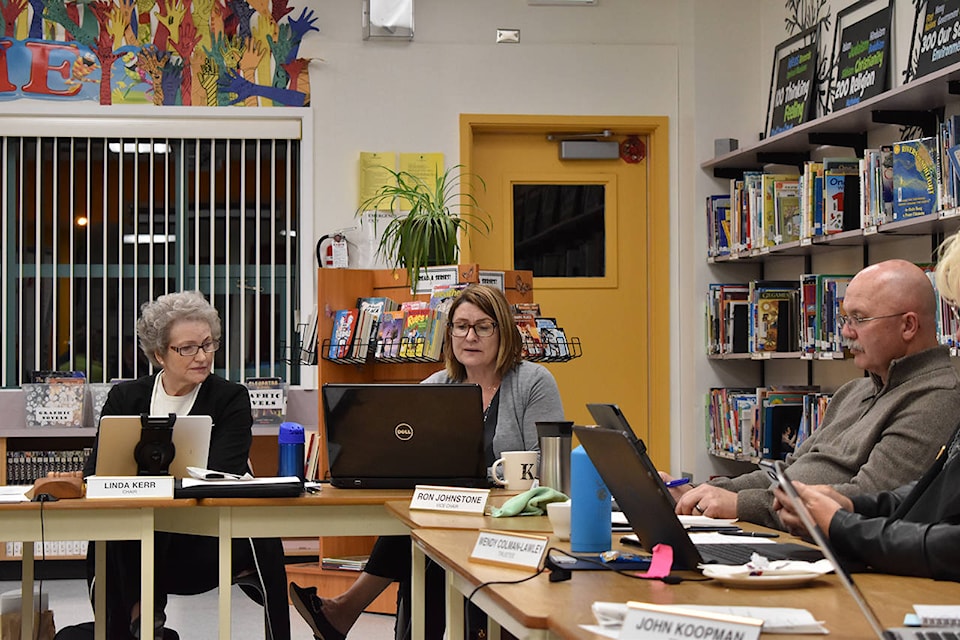It’s looking to be a status quo budget for 2019-20 in the Fraser-Cascade School District.
“I’ve said this year over year, but this is another status quo budget,” district secretary-treasurer Natalie Lowe said at the school board meeting Tuesday (April 16). “It hasn’t been too difficult to balance the budget, but it doesn’t mean a lot of extra room for extra projects.”
The $25.5 million budget will see some increases in funding from the province, including $163,264 to offset the additional cost from the Employer Health Tax and an extra $397,002 for the Classroom Enhancement fund to restore 2002 class size language. These increases are largely to compensate for additional costs to the district.
Other costs to the district haven’t been covered by the province.
As a whole, the province has taken $2 million to pay for copyright infringement going back to 2013. The cost is around $4.38 per full-time student, and will be taken from districts until the debt is repaid.
Carbon tax is also an increasing cost — the tax is increasing to $50 a ton by 2021, and will cost the district an extra $10,000 a year — although it is put into a fund the district can use for carbon-related capital projects.
SEE ALSO: B.C. school district funding changes delayed until after next year
Despite some of the increasing expenses, ministry grants and district revenue came pretty close to creating a balanced budget. The district is using about $1.8 million from its reserves to balance the remainder.
The preliminary operating grant from the province has increased, partly because of increases to per-student funding for the district. The base grant for each full-time student will be $7,468 in 2019-20, up from $7,423 in 2019-18.
The largest increases were for physically-dependent special needs students ($42,400 up from $38,800) and Indigenous students ($1,450 up from $1,230).
“I think that was in recognition that we need to work to ensure … there’s more focus on relationships between Aboriginal communities and schools” Lowe said about the increase for Indigenous students.
The number of students in the school district is projected to stay about the same as the 2018-19 school year, Lowe said, although she added that her predictions had been wrong before.
“I’m anticipating pretty much a static enrolment for next year,” she said. “I was wrong last year, and we had a little bit of an increase.”
On the whole, the district has been seeing an upwards trend in the number of students coming into its schools. Lowe expects to continue to see that trend, especially in Agassiz, as more families in the Lower Mainland move east to more affordable communities.
“We’re starting to see that in our numbers in Kent and Agassiz, and it’s starting to roll out to Hope already,” she said. “We have space right now, and we have plans to be able to accommodate more students.”
Like the total enrolment, the district isn’t expecting a major change to the number of students with special needs designations, although an increase is possible.
In 2018-19, there were a total of 244 students with special needs in the district, about 14 per cent of the total student population. The district is expecting at least that many special needs students in 2019-20.
Provincially, there is expected to be 484 additional students with special needs designations.
Staff salaries are another unknown in the 2019-20 budget. The district is in the middle of contract negotiations with teachers and support staff, and won’t know how much the bargaining may cost.
Salaries currently make up around 68 per cent of the district’s operating expenses, with the average teacher making $75,214 in 2018-19.
Few staff layoffs are expected in the 2019-20 budget. For teachers, several temporary positions are ending, but those jobs are being filled by staff who had been on leave.
Eight support staff have been laid off, but may be rehired depending on where the need is in schools.
The budget presentation to the school board on Tuesday was largely for information. The May 10 meeting will see the board give first reading to the budget; the final budget must be approved and sent to the ministry of education by June 30.
grace.kennedy@ahobserver.com
Like us on Facebook and follow us on Twitter
